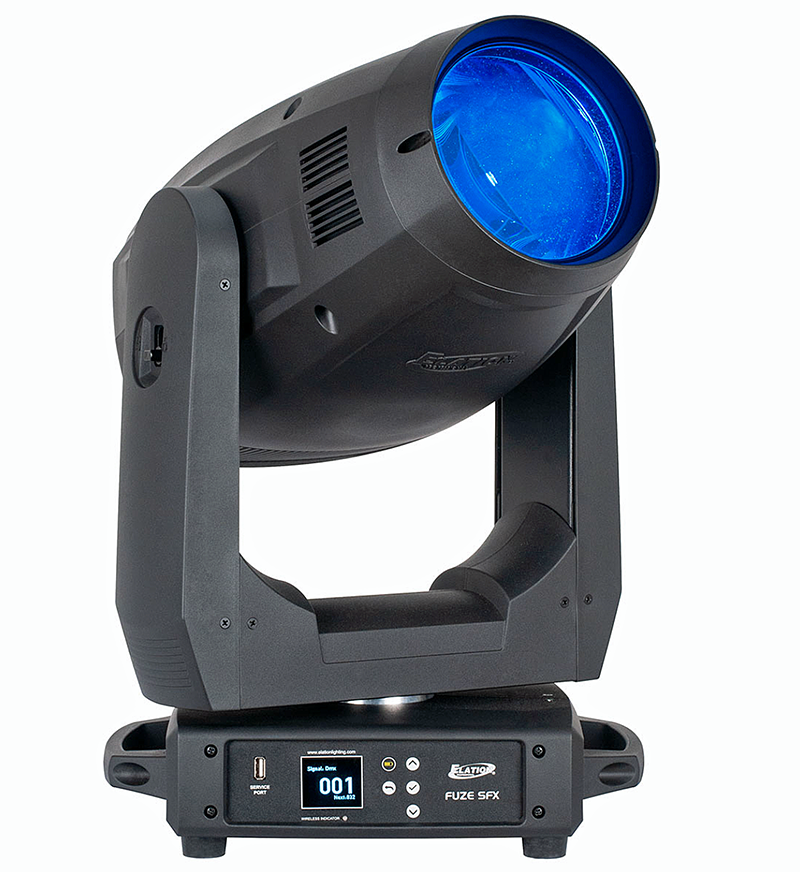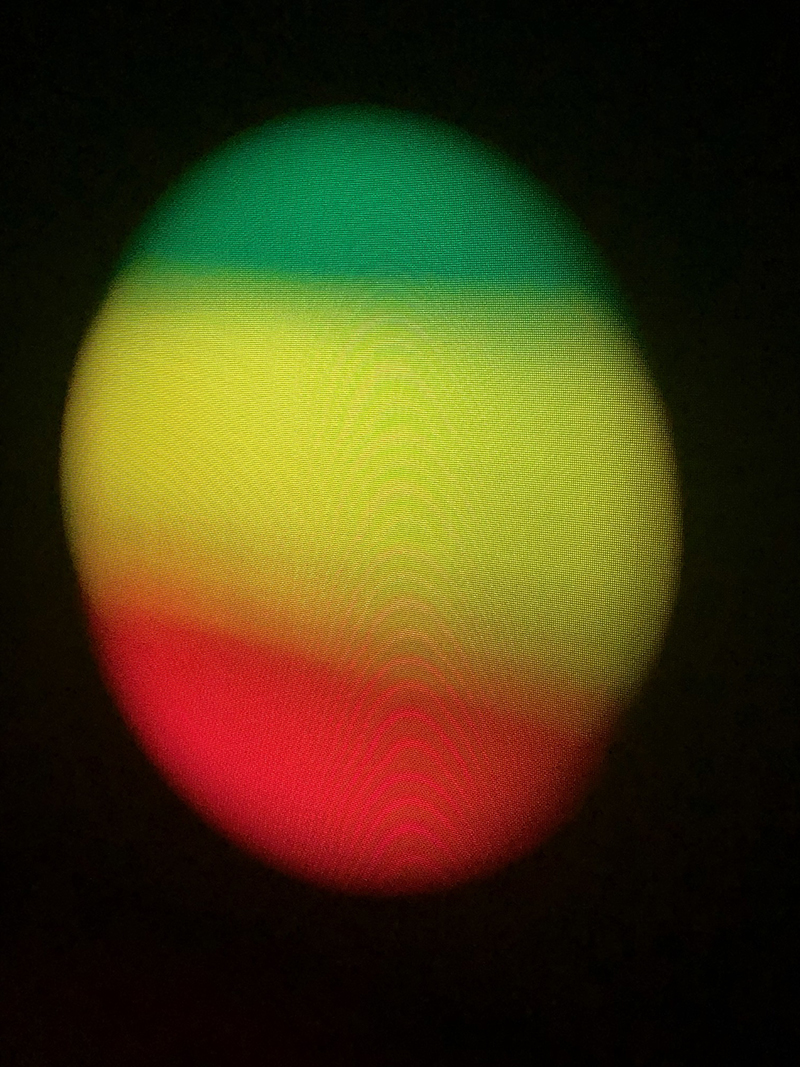
It’s been quite a while since I took one of these small moving lights for a test drive. The game has certainly changed since they first appeared on the market (for reference, the Studio Spot 250 was released in 1999). Back then, these type of fixtures were relatively dim, but more problematic was that each manufacturer made their own model and none of these had all of the attributes an LD wanted. You might have an iris, but no zoom capability. As a result, designers got inexpensive movers, but had to choose between different manufacturers’ offerings to choose which spot fixture had the features best suited for a particular job. Twenty years later, I’m here to say that’s all out the window — the Elation Fuze SFX does it all.

Footprints and Outputs
This is a 300-watt white LED engine-sourced moving spot on a yoke. The SFX stands for Spot + Effects. Its small footprint is aided by a thin base, but upon opening up the shell, one can see there is not a single micrometer of space wasted on the assembly. Boasting 12,000 lumens of even light output, it supersedes the old arc light fixtures that were lucky to offer 5000 lumens. The light source has a life span of 20,000 hours. Weighing 46 pounds, it’s simple to grip by the handles on the base, and I notice the yoke locks.
The aperture of the front lens is about 5” in diameter, which I prefer to the tiny output lens of old spot fixtures. The first thing I check out is the zoom range. It’s 4.5° to 38°, which seems baffling for a fixture that is under two feet tall. It can execute the zoom mechanics fast enough to make a nice chase easily. The replication of a small beam is commendable, especially when the iris is implemented to reduce the hole size. The iris works well on its own and has some pulsing macro effects included, but I will say they seem to lack speed. This is probably just a software fix as the mechanical iris functions quickly on command.
The dimmer and strobe functions are not mechanical and perform flawlessly. A 30-second fade time revealed no stepping at all in the dimmer. Random and sync strobe functions work well. The PWM can be set between 900-20,000 Hz as part of a control channel, set from the console.
Color and Effects
The Fuze SFX has a native color temperature of 6600K. This makes the output quite punchy, especially when thrown out of focus to give it a sweet hot spot on center. It’s also able to achieve a perfectly flat field of light with no ring of color noticeable around the perimeter when shown on a wall. But it does mean the colors do not reach as perfect a saturation as other Elation fixtures one may be accustomed to. The red is good, but not blood. The fixture comes with a CYM mixing system with all three color wheels, as opposed to blades, each offering a sweet saturated hue. A royal blue can be achieved, though a deep Congo blue seems to be absent from this fixture.
The software in a control channel allows the individual color wheels to overshoot 100% saturation and mix a half color (or any other percentage) of white with the original saturated color. Hence you can take the magenta wheel and split in half, then roll in the yellow wheel, and you have a nice red/yellow beam emitted. On top of that, the user can choose how much separation they want between the two colors. I can dial it up to have a thick black band separating the light output into two distinctive beams if I wish. Adjusting the focus of the beam can eliminate that black band that’s separating the colors easily.
The colors can snap quickly and can work well in conjunction with the separate seven hole fixed color wheel. To take half colors to yet another step, I am able to split the output into three separate colors on a wall by indexing a half color from the standard wheel submitted partially into the beam and adding in half colors from the mixing wheels. (See Fig. 1)

Both the dedicated color wheel and the CMY wheels have the ability to continuously spin. The wheel gives you a rainbow chase effect, while the individual cyan wheel will give the user more of a blue/white chase effect when spun quickly. The color wheels do not spin fast enough to give me a color strobe effect (dang it). I will say that Elation seems to have covered the color systems better than any other manufacturer as far as the 7-way Spectral type utilized in their Artiste range or the new model designed for this SFX system.
Mind you, the Fuze SFX does not have a variable color temperature wheel, but there is a dichroic CTO on the wheel and can be mixed easily enough. The native CRI of this fixture is 68, but that can be upped with a filter in the color wheel as well.
Gobo-wise, I’m happy to say that this hard-to-please LD is pretty excited about what they have to offer as far as patterns — none of the same usual “Night Sky” breakups, but all unique new patterns. Sure, they have some paint brush type swipes and shower glass gobos that are necessary for texturing scenery, but the aerial gobos are really well thought out. The rotating wheel contains eight replaceable, indexable glass gobos. The other wheel is stamped with ten patterns. The first one is a small hole gobo, perfect for chasing between an open and tight beam quickly. Some of the other stamped holes slightly resemble shapes you may be accustomed to, so no worries there about missing an old fave; you’ll be pleased.
I can sharpen each gobo at any zoom size and can easily morph from one gobo to another as well as combine them together in one image. The variable frost works well. I can soften the texture on either wheel, often coming up with some cool patterns of the wall as I mess around with it. Prism-wise, the fixture includes dual independent ones, 6-hole linear and circular models that can spin at variable speeds in either direction and are indexable as well, a bonus not found in most fixtures.
Hardware and Control
This compact fixture moves quickly, giving the user a 540° pan and normal tilt range. Both mechanisms can lock for travel 5-pin XLR connectors as well as RJ45, AC connectors have IP65 caps to keep them waterproof, and the fixture itself has an IP20 rating. It requires 31 channels of DMX, and there is only one mode of operation. It can also accept Art-Net, and sACN protocols. New firmware can be loaded via a USB connection, and the fixture comes equipped with Elation’s E-Fly wireless capabilities. Setup was simple via a (4) Button Touch control panel with full color 180° reversible LCD menu display. There is a channel to remotely control the fan, but I couldn’t even hear it running. The fixture didn’t even get warm after being left on for 30 minutes.
At a Glance:
A Multi-Trick Pony
This compact workhorse is the best full function, small spot fixture on the market. The extra FX added to the light are novel and impressive — perfect for any floor light, corporate gig, club, theater sized show or house of worship.
Elation Fuze SFX
PROS: Bright for its size, has all the bells and whistles plus many added FX. Macro effects for premade gobo/frost/prism looks.
CONS: Slow iris macros
FEATURES
- 300W LED 6,600K White LED Engine
- 12,000 Total Lumen Fixture Output
- Variable CMY and Color Wheel
- Variable Wash Frost Filter
- Motorized Iris
SPECS
- Light Source: LED (300W)
- Lamp Life: 20,000 hours
- Total Wattage: 432W
- Gobos: 8 rotating, 10 static
- Color Mixing: CMY mixing wheels with overdrive
- Color Wheel: 7 slots
- Prisms: 6 way linear, 6-facet round
- Frost: Variable
- Zoom: 4.5°-38°
- MSRP: $3,196
Manufacturer: Elation
More Info: www.elationlighting.com


